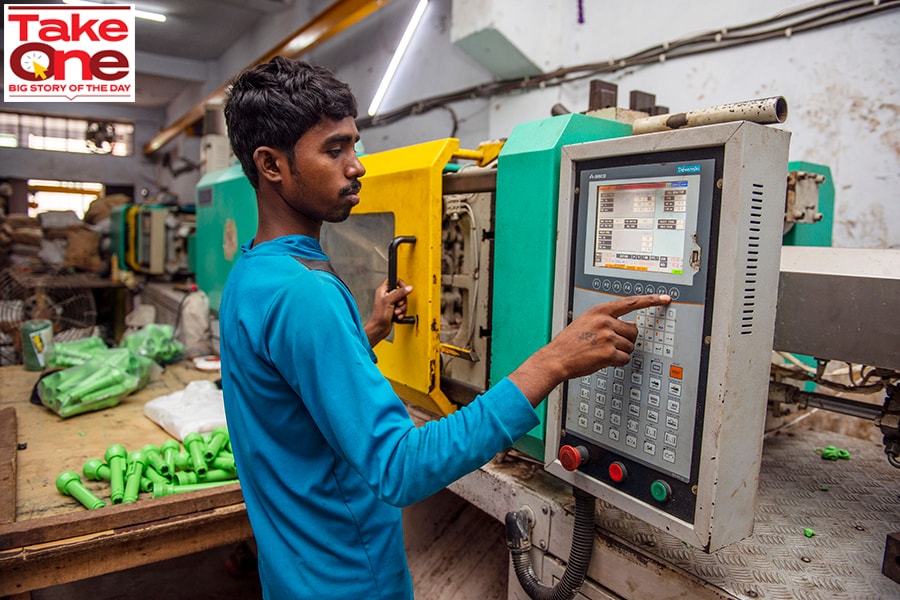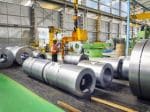Has India Inc survived brutal heatwaves and election-related uncertainty in the April-June quarter?
How companies managed to keep sailing through turbulence in the first quarter of FY25, which saw two major challenges in the form of general elections and brutal heatwaves in many regions of the country
 A worker operates an automatic moulding machine at a plastic product manufacturers factory in New Delhi.
Image: Pradeep Gaur/SOPA Images/LightRocket via Getty Images
A worker operates an automatic moulding machine at a plastic product manufacturers factory in New Delhi.
Image: Pradeep Gaur/SOPA Images/LightRocket via Getty Images
Corporate earnings for April to June period are expected to show impacts of severe heatwaves and uncertainties related to general elections. Overall earnings in first quarter of financial year 2025 are likely to show growth at a moderate pace. While oil marketing companies (OMCs) may drag, few sectors like banks and metals may be key earnings drivers.
Even as markets have seen rough patches of volatility in the voting phase from April 19 to June 1 of Lok Sabha elections, equities have made a phenomenal strike with returns, in a way running ahead of fundamentals. The Q1FY25 earnings, therefore, will be a litmus test and an assessment if the super rally is supported by real business growth. In the three months ending June, both benchmark indices Nifty and Sensex gained over 7 percent despite a massive crash of stocks on the day of election results as exit polls predictions did not tally with the actual poll results.
“In FY23, the companies under our coverage witnessed a sharp drag on margins as commodity prices surged during the Russia-Ukraine war. This resulted in just 11 percent earnings growth of these companies, despite 24 percent revenue growth. FY24 saw a reversal of this trend, as commodity prices moderated and margins sharply rebounded. Thus, these companies posted 31 percent earnings growth despite just 4 percent revenue growth. Now for FY25, we expect earnings to normalise and track the revenue trend,” Duggad explains.
Sector-wise, he feels earnings growth is likely to be driven once again by domestic cyclicals, such as banking, financial services, and insurance (BFSI) and auto, while contributions from metals and healthcare would rise. The auto sector’s earnings are likely to improve 18 percent (YoY), the lowest in nine quarters. Consumption growth may continue to remain a key pain point with rural recovery not much visible in Q1FY25 but expectation of government initiatives may be a driver. In the consumer segment, companies focussed on summer products from ice-creams to air conditioners are expected to outperform.
Analysts at Kotak Institutional Equities expect Q1FY25 net income of companies under its coverage to decline 1.8 percent YoY, led by a sharp decline in the net income of OMCs. Excluding OMCs, it expects net income to grow 9.3 percent YoY. In Q1FY24, OMCs had large over-recoveries in retail sales of diesel and gasoline.
Kotak Institutional Equities sees Q1FY25 net profit of the companies on the Sensex to increase 8.1 percent YoY but decline 8.4 percent quarter-on-quarter. Similarly, for Nifty companies, net profit is likely to be flat on annual basis but 10.7 percent lower on sequential bases. It estimates earning per share (EPS) of Sensex at Rs3,521 for FY2025 and Rs4,063 for FY2026 and of the Nifty at Rs1,093 for FY2025 and Rs1,249 for FY2026.
What to watch out for?
Analysts will watch out for managements’ commentaries on margins and guidance for rest of FY25 as a major overhang of elections is over for now.Q1FY25 earnings season was marked by robust Purchasing Managers' Index (PMI) manufacturing and services, stronger e-way bill and GST collection, heat waves, electricity demand due to it, and election campaigns and rallies. “Domestic-facing sectors largely enjoyed the economic recovery backed by these factors and hence, margins may surprise positively,” says Neeraj Chadawar, head of research, Axis Securities.
Export-oriented themes are likely to showcase relatively weaker performance. Most of the domestic high-frequency indicators have trended higher during the quarter which is likely to translate into good demand momentum for the domestic corporate segment.
Following a strong FY24 which showed an over 20 percent net profit growth, analysts at Nuvama Institutional Equities forecast profits of companies under their coverage (excluding OMCs) to moderate to 7 percent. On the whole, they anticipate Nifty earnings to grow two percent YoY in Q1FY25. With margin tailwinds fading, top line needs to recover where signs are not yet visible); else there could be risks to FY24–26 consensus EPS growth forecasts of 15–16 percent, they add.
Overall, divergences seen in FY24 are reconciling with profit and top-line growth gap narrowing as tailwinds of lower BFSI credit costs and input prices fade. Within demand too, sectoral dispersion is narrowing. “This poses risk to FY25 EPS growth of 15 percent, but sectoral churn in earnings is likely. FY24’s leaders could potentially lag in FY25,” explain analysts at Nuvama Institutional Equities.
Also read: India stares at higher food prices with fears of weak monsoon
Input costs ebb and flow
Few factors like price cuts, consumer offers by companies, and rise in demand of summer related products may have possibly helped in volume growth of FMCG companies in Q1FY25. However, steep inflation in agriculture products and other commodities may pinch margins once again.The overall commodity cost basket stabilised during the quarter, rising 1.7 percent YoY and 1.5 percent quarter-on-quarter (QoQ). The agricultural basket increased 3.6 percent YoY and 3.1 percent QoQ. There was a decrease in prices of mentha oil and milk powder, whereas prices of palm oil, sugar, wheat, tea, coffee and maize increased. The non-agricultural commodity basket declined two percent YoY and 1.7percent QoQ, offsetting the rise in agri commodity prices.
In the agricultural basket, maize prices went up by 17 percent YoY and currently at Rs24 per kg. Coffee prices continued to rise by 15 percent YoY (two percent QoQ) due to labour shortages and higher demand.
Tea prices increased sharply during the quarter after a moderation in Q4FY24 and went up by 31 percent QoQ and four percent YoY due to geopolitical issues, climate change and changing consumer preferences. Wheat prices rose 10 percent YoY to Rs26 per kg, aided by government support to farmers. Barley prices remained flat YoY at Rs21 per kg. Sugar prices increased by eight percent YoY to Rs39 per kg. Mentha oil prices dropped 14 percent YoY to Rs975 per kg. Malaysian palm oil prices increased by five percent YoY while palm fatty acid prices rose six percent YoY. Brent crude price has gone up in Q1FY25 after seeing a short downward trend on a quarterly basis (up by 2.2 percent QoQ in Q1FY25).
“Raw material prices have seen uptick but not alarming as of now,” says Mehul Desai of JM Financials. Moreover, net pricing decline has tapered further and likely to turn positive in coming quarters. According to Desai, some amount of inflation is beneficial for staples as it provides pricing lever and also keeps regional competition/aggressive promotions under check.
Stocks of companies in staples business have seen healthy run-up in anticipation of acceleration in volume growth led by rural recovery – lot of hope is pinned on normal monsoons and likelihood of favourable government policy to boost consumption (especially rural) going ahead,” Desai adds. While demand trends point to some recovery, sustained improvement will be key things to be monitored.
Elections: Low order and labour shortage
Due to elections, the government’s ordering activity slowed down. During the quarter, L&T announced orders worth Rs183 billion, BHEL won Rs43 billion, Kalpataru Projects International acquired Rs23 billion. There were cases of labour shortages impacting production in FMCG companies, manufacturing units and overall work in capital goods related companies.“Due to general elections in India during the quarter, the availability of labour and temporary halting of construction of government projects may have hit the projects business of most companies,” say analysts at InCred Equities.
Alcohol beverages were affected by election-related restrictions and there are some supply-side constraints limiting the sales
Going forward, the monsoon and the Union Budget on July 23 will be critical for consumption growth and overall business environment. Markets are expected to be driven by few factors such as macroeconomic developments, budget, Q1FY25 earnings, monsoon and bond yields and liquidity flows.

















